MiR-625-3p promotes cell migration and invasion via inhibition of SCAI in colorectal carcinoma cells
- PMID: 26314959
- PMCID: PMC4695027
- DOI: 10.18632/oncotarget.4738
MiR-625-3p promotes cell migration and invasion via inhibition of SCAI in colorectal carcinoma cells
Abstract
MicroRNAs (miRNAs) play a critical role in controlling tumor invasion and metastasis via regulating the expression of a variety of targets, which act as oncogenes or tumor suppressor genes. Abnormally expressed miR-625-3p has been observed in several types of human cancers. However, the molecular mechanisms of miR-625-3p-mediated tumorigenesis are largely elusive. Therefore, the aim of this study was to evaluate the biological function and molecular insight on miR-625-3p-induced oncogenesis in colorectal carcinoma (CRC). The effects of miR-625-3p in cell migration and invasion were analyzed by wound healing assay and transwell assay, respectively. In addition, the expression of miR-625-3p and its targets was detected in five human CRC cell lines. In the present study, we found that overexpression of miR-625-3p promoted migration and invasion in SW480 cells, whereas downregulation of miR-625-3p inhibited cell motility in SW620 cells. More importantly, we observed potential binding sites for miR-625-3p in the 3'-untranslated region of suppressor of cancer cell invasion (SCAI). Notably, we identified that overexpression of miR-625-3p inhibited the expression of SCAI, while depletion of miR-625-3p increased SCAI level, suggesting that SCAI could be a target of miR-625-3p. Additionally, we revealed that miR-625-3p exerts its oncogenic functions through regulation of SCAI/E-cadherin/MMP-9 pathways. Our findings indicate the pivotal role of miR-625-3p in invasion that warrants further exploration whether targeting miR-625-3p could be a promising approach for the treatment of CRC.
Keywords: SCAI; colorectal carcinoma; invasion; miR-625-3p; migration.
Conflict of interest statement
The authors declare that they have no conflict of interest.
Figures
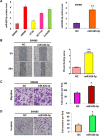
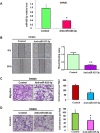
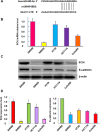
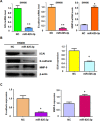
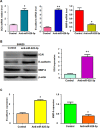

Similar articles
-
MicroRNA-490-3p inhibits colorectal cancer metastasis by targeting TGFβR1.BMC Cancer. 2015 Dec 29;15:1023. doi: 10.1186/s12885-015-2032-0. BMC Cancer. 2015. PMID: 26714817 Free PMC article.
-
MiR-27b-3p promotes migration and invasion in colorectal cancer cells by targeting HOXA10.Biosci Rep. 2019 Dec 20;39(12):BSR20191087. doi: 10.1042/BSR20191087. Biosci Rep. 2019. PMID: 31763673 Free PMC article.
-
Downregulation of microRNA-409-3p promotes aggressiveness and metastasis in colorectal cancer: an indication for personalized medicine.J Transl Med. 2015 Jun 18;13:195. doi: 10.1186/s12967-015-0533-x. J Transl Med. 2015. PMID: 26084278 Free PMC article.
-
MicroRNA-338-3p inhibits colorectal carcinoma cell invasion and migration by targeting smoothened.Jpn J Clin Oncol. 2014 Jan;44(1):13-21. doi: 10.1093/jjco/hyt181. Epub 2013 Nov 25. Jpn J Clin Oncol. 2014. PMID: 24277750
-
MiR-101: a potential therapeutic target of cancers.Am J Transl Res. 2018 Nov 15;10(11):3310-3321. eCollection 2018. Am J Transl Res. 2018. PMID: 30662588 Free PMC article. Review.
Cited by
-
miR-1290 contributes to oncogenesis and angiogenesis via targeting of THBS1, DKK3 and, SCAI.Bioimpacts. 2022;12(4):349-358. doi: 10.34172/bi.2021.23571. Epub 2021 Nov 3. Bioimpacts. 2022. PMID: 35975203 Free PMC article.
-
Network-based analysis implies critical roles of microRNAs in the long-term cellular responses to gold nanoparticles.Nanoscale. 2020 Nov 7;12(41):21172-21187. doi: 10.1039/d0nr04701e. Epub 2020 Sep 29. Nanoscale. 2020. PMID: 32990715 Free PMC article.
-
MicroRNA-375 suppresses human colorectal cancer metastasis by targeting Frizzled 8.Oncotarget. 2016 Jun 28;7(26):40644-40656. doi: 10.18632/oncotarget.9811. Oncotarget. 2016. PMID: 27276676 Free PMC article.
-
microRNA-625 inhibits tumorigenicity by suppressing proliferation, migration and invasion in malignant melanoma.Oncotarget. 2017 Feb 21;8(8):13253-13263. doi: 10.18632/oncotarget.14710. Oncotarget. 2017. PMID: 28129648 Free PMC article.
-
microRNA-222 promotes colorectal cancer cell migration and invasion by targeting MST3.FEBS Open Bio. 2019 May;9(5):901-913. doi: 10.1002/2211-5463.12623. Epub 2019 Apr 2. FEBS Open Bio. 2019. PMID: 31034165 Free PMC article.
References
Publication types
MeSH terms
Substances
LinkOut - more resources
Full Text Sources
Other Literature Sources
Medical

